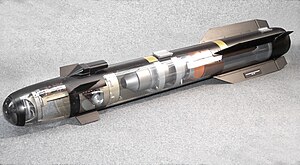
Back إيه جي إم-114 هيلفاير Arabic AGM-114 Hellfire Azerbaijani AGM-114 Bulgarian AGM-114 Hellfire BS AGM-114 Hellfire Catalan AGM-114 Hellfire Czech AGM-114 Hellfire German AGM-114 Hellfire Esperanto AGM-114 Hellfire Spanish ایجیام-۱۱۴ هلفایر Persian
| AGM-114 Hellfire | |
|---|---|
 A model of Longbow Hellfire's components | |
| Type | Air-to-surface and surface-to-surface missile |
| Place of origin | United States |
| Service history | |
| In service | 1984–present |
| Wars | 1991 Gulf War War on Terror Russian Invasion of Ukraine |
| Production history | |
| Manufacturer | Lockheed Martin, Boeing (prior second source), and Northrop Grumman (seeker only for AGM-114L Longbow Hellfire) |
| Unit cost | US$150,000[1]
(FY 2021) US$117,000 (FY2017)[2] |
| Produced | 1974–present |
| Specifications | |
| Mass | 100–108 lb (45–49 kg)[3] |
| Length | 64 in (1.6 m) |
| Diameter | 7 in (180 mm) |
| Wingspan | 13 in (0.33 m) |
| Warhead | |
| Engine | Thiokol TX-657[4][5] Solid-fuel rocket |
| Propellant | APC/HTPB |
Operational range | 550 to 12,030 yd (0.5 to 11 km) |
| Maximum speed | Mach 1.3 (995 mph; 1,601 km/h) |
Guidance system | |
Launch platform | Rotary- and fixed-wing aircraft, unmanned combat aerial vehicles, tripods, ships, ground vehicles |
The AGM-114 Hellfire is an American air-to-surface missile (ASM) first developed for anti-armor use,[6] later developed for precision[7] drone strikes against other target types, especially high-value targets.[8] It was originally developed under the name "Heliborne laser, fire-and-forget missile", which led to the colloquial name "Hellfire" ultimately becoming the missile's formal name.[9] It has a multi-mission, multi-target precision-strike ability and can be launched from multiple air, sea, and ground platforms, including the MQ-1 Predator and MQ-9 Reaper. The Hellfire missile is the primary 100-pound (45 kg) class air-to-ground precision weapon for the armed forces of the United States and many other nations. It has also been fielded on surface platforms in the surface-to-surface and surface-to-air roles.[10]
- ^ "Ultimate Guide on AGM-114 Hellfire Missile: Capabilities, Variants, and Cost". The Defense Post. 22 March 2021.
- ^ "United States Department Of Defense Fiscal Year 2017 Budget Request Program Acquisition Cost By Weapon System" (PDF). Office of the Under Secretary of Defense (Comptroller)/Chief Financial Officer. January 2016. p. 58. Archived (PDF) from the original on 1 December 2017. Retrieved 18 November 2017.
- ^ Weapon Systems. Department of the Army, Office of the Deputy Chief of Staff for Research, Development, and Acquisition. 1998. pp. 125, 215. ISBN 978-0-16-049429-1. Retrieved 19 September 2023.
- ^ Parsch, Andreas. "Boeing/Lockheed Martin (Rockwell/Martin Marietta) AGM-114 Hellfire". Directory of U.S. Military Rockets and Missiles.
The AGM-114B also introduced the Thiokol TX-657 (M120E1) reduced-smoke rocket motor.
- ^ Spring 2014 Industry Study (PDF), National Defence University, Fort McNair, Washington, DC, p. 10, archived (PDF) from the original on 9 October 2022,
The component that ... propels the Hellfire is the Thiokol TX-657.
- ^ "AGM-114 Hellfire". Military.com. Retrieved 26 July 2020.
- ^ "Ayman al-Zawahiri: Taking down a terrorist". The Times of India. India. 3 August 2022. Retrieved 3 August 2022.
- ^ Hallion, Richard P. (2018). "Chapter 4: Science, Technology and Air Warfare". In Olsen, John Andreas (ed.). Routledge Handbook of Air Power. Routledge. p. 52. ISBN 978-1-315-20813-8.
- ^ "World Missile Yearbook". Archived from the original on 16 February 2017. Flight International, 14 March 1974.
- ^ J. FREEDBERG JR., SYDNEY (10 July 2018). "Army Anti-Aircraft Stryker Can Kill Tanks Too". breakingdefense.com. Breaking Defense. Retrieved 1 July 2021.
© MMXXIII Rich X Search. We shall prevail. All rights reserved. Rich X Search